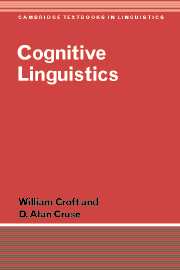Crossref Citations
This Book has been
cited by the following publications. This list is generated based on data provided by Crossref.
Koch, Peter
2005.
Aspects cognitifs d'une typologie lexicale synchronique. Les hiérarchies conceptuelles en français et dans d'autres langues.
Langue française,
Vol. n° 145,
Issue. 1,
p.
11.
Wikberg, Kay
2005.
Review of Halliday, Teubert, Yallop & Čermáková (2004): Lexicology and Corpus Linguistics. An Introduction.
Languages in Contrast,
Vol. 5,
Issue. 2,
p.
301.
Paradis, Carita
2005.
Ontologies and Construals in Lexical Semantics.
Axiomathes,
Vol. 15,
Issue. 4,
p.
541.
Tummers, Jose
Heylen, Kris
and
Geeraerts, Dirk
2005.
Usage-based approaches in Cognitive Linguistics: A technical state of the art.
Corpus Linguistics and Linguistic Theory,
Vol. 1,
Issue. 2,
Sowa, John F.
2006.
Language, Cohesion and Form Margaret Masterman (1910–1986) (Edited by Yorick Wilks, University of Sheffield), Cambridge University Press (Studies in natural language processing, edited by Steven Bird and Branimir Boguraev), 2005, x+312 pp; hardbound, ISBN 0-521-45489-1, $95.00, £55.00; eBook, ISBN 0-511-13318-9, $76.00.
Computational Linguistics,
Vol. 32,
Issue. 4,
p.
551.
IWATA, SEIZI
2006.
Where Do Constructions Come From? (W. Croft, Radical Construction Grammar: Syntactic Theory in Typological Perspective).
ENGLISH LINGUISTICS,
Vol. 23,
Issue. 2,
p.
493.
Silverstein, Michael
2006.
Old Wine, New Ethnographic Lexicography.
Annual Review of Anthropology,
Vol. 35,
Issue. 1,
p.
481.
Moonen, Machteld
de Graaff, Rick
and
Westhoff, Gerard
2006.
Focused Tasks, Mental Actions and Second Language Learning. Cognitive and Connectionist Accounts of Task Effectiveness.
ITL - International Journal of Applied Linguistics,
Vol. 152,
Issue. ,
p.
35.
Hendrikse, Rusandré
and
Poulos, George
2006.
Tagging an agglutinating language: A new look at word categories in the southern African indigenous languages.
Language Matters,
Vol. 37,
Issue. 2,
p.
246.
Itti, Laurent
and
Arbib, Michael A.
2006.
Action to Language via the Mirror Neuron System.
p.
289.
Kemmerer, David
2006.
Action to Language via the Mirror Neuron System.
p.
347.
2006.
Références bibliographiques.
Langue française,
Vol. n° 150,
Issue. 2,
p.
119.
Buetow, Stephen
and
Adams, Peter
2006.
Is There Any Ideal of ‘High Quality Care’ Opposing ‘Low Quality Care’? A Deconstructionist Reading.
Health Care Analysis,
Vol. 14,
Issue. 2,
p.
123.
Klein, Perry D.
2006.
The Challenges of Scientific Literacy: From the viewpoint of second‐generation cognitive science.
International Journal of Science Education,
Vol. 28,
Issue. 2-3,
p.
143.
Legallois, Dominique
and
Grea, Philippe
2006.
L’objectif de cet article est de… Construction spécificationnelle et grammaire phraséologique.
Cahiers de praxématique,
p.
161.
O'Connell, Daniel C.
and
Kowal, Sabine
2006.
Verbal Integrity.
Journal of Social Distress and the Homeless,
Vol. 15,
Issue. 3,
p.
207.
Čarapić, Aleksandar
2006.
Review of Cohen & Lefebvre (2005): Handbook of Categorization in Cognitive Science.
Pragmatics & Cognition,
Vol. 14,
Issue. 3,
p.
601.
Lapaire, Jean-Rémi
2006.
La Négation.
p.
333.
LANTOLF, JAMES P.
and
JOHNSON, KAREN E.
2007.
Extending Firth and Wagner's (1997) Ontological Perspective to L2 Classroom Praxis and Teacher Education.
The Modern Language Journal,
Vol. 91,
Issue. s1,
p.
877.
Lu, Louis Wei-lun
and
Chiang, Wen-yu
2007.
Emptiness We Live By: Metaphors and Paradoxes in Buddhism's Heart Sutra.
Metaphor and Symbol,
Vol. 22,
Issue. 4,
p.
331.



